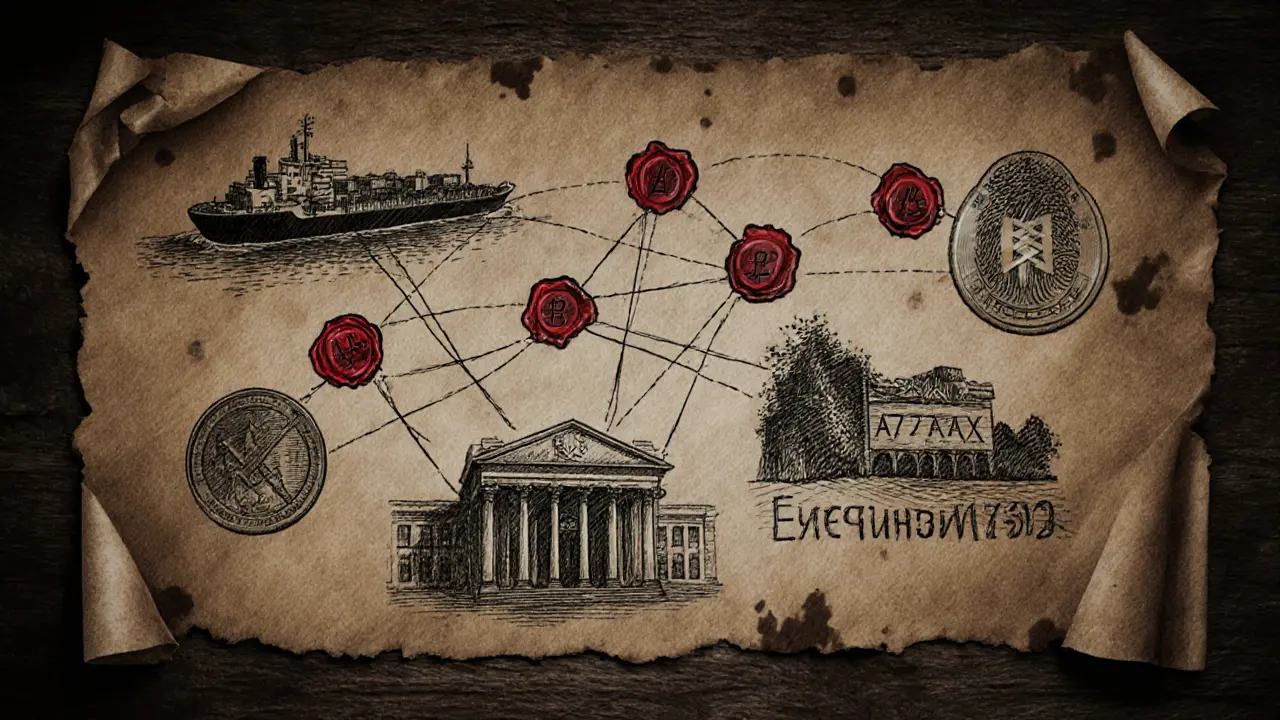Sanctions Evasion Feasibility Calculator
How Crypto Bypasses Sanctions
Based on Russia's experience since 2025, this calculator demonstrates why crypto can't fully replace traditional finance for sanctions evasion. Enter values to see the feasibility gap.
Evasion Feasibility Analysis
Enter values above to see the feasibility analysis
When Russia legalized cryptocurrency mining in 2025, it wasn’t just about energy efficiency or tech innovation. It was a calculated move to keep its economy alive under crippling Western sanctions. The goal? Replace dollar-based trade with crypto rails no one can easily shut down. And for a while, it looked like it might work.
How Russia Turned Mining Into a Sanctions Shield
Russia didn’t just allow crypto mining-it built an entire parallel financial system around it. By 2025, the country had the third-largest crypto mining industry in the world, using cheap Siberian power to run massive server farms. But mining alone doesn’t move goods or pay for weapons. So Russia added something else: a state-backed stablecoin called A7A5. A7A5 isn’t Bitcoin. It’s not volatile. It’s pegged to the ruble and issued by Old Vector, a company based in Kyrgyzstan but funded by Russia’s state-owned Promsvyazbank. Launched in February 2025, it quickly became the backbone of Russia’s shadow economy. By July 2025, over $51 billion had flowed through it. That’s not retail traders buying coins on Binance. That’s factories paying for parts, oil traders swapping crude for tokens, and military suppliers getting paid without touching a Western bank. The system works like this: a Russian company sells oil to a buyer in Turkey. Instead of using SWIFT or a dollar account, they use A7A5. The buyer gets tokens, sells them on a Russian-linked exchange like Grinex (created in 2024 by ex-Garantex staff), and converts them into local currency. No U.S. banks involved. No sanctions triggers. Just blockchain.The Exchanges That Keep the System Running
The whole setup depends on a small, tightly connected network of exchanges. Garantex was the first major Russian crypto exchange to get sanctioned by the U.S. in 2022. But instead of shutting down, its operators just built a new one: Grinex. By August 2025, the U.S. Treasury had sanctioned Grinex too, calling it a “sanctions evasion platform designed to bypass U.S. controls.” These aren’t global platforms like Coinbase or Kraken. They’re niche, Russia-focused, and designed to avoid detection. They operate on the fringes of the crypto world, using shell companies in Kyrgyzstan, Moldova, and Luxembourg to hide ownership. The UK sanctioned eight entities tied to A7A5’s network, including banks in Kyrgyzstan that allegedly helped move money for Russian defense contractors. Even more telling: the A7A5 website started advertising that you could buy tokens directly with PSB bank cards-Russia’s Promsvyazbank. That’s not just for businesses anymore. It’s creeping into retail. Ordinary Russians can now buy crypto with their salary accounts. That’s how you build a parallel economy: by making it easy for everyone to use.
Western Sanctions Hit Back-Hard
The U.S. didn’t sit back. On August 20, 2025, the Treasury Department did something unprecedented: it sanctioned a crypto mining company. That’s right. Not just an exchange. Not just a wallet provider. A mining company. This was the first time any government had labeled mining as a sanctions evasion tool. The target? A Siberian mining operation linked to Russian defense suppliers. The message was clear: if you’re using electricity and hardware to power a crypto network that helps Russia avoid sanctions, you’re a target. The UK followed with its own sanctions on Grinex, Old Vector, and three Kyrgyz banks. These aren’t symbolic moves. They’re surgical. The Treasury didn’t just freeze accounts-they froze the people behind them. Konstantin Malofeyev, a Russian oligarch long tied to pro-Kremlin financial networks, had over 40 entities and individuals under his control sanctioned in one go. That’s not random. That’s mapping the whole network: miners, exchanges, banks, lawyers, even the consultants who helped set up the A7A5 system.Why It’s Not Working as Well as Russia Hoped
Here’s the catch: crypto isn’t magic. It can’t replace the dollar. Russia’s annual exports before the war were worth about $400 billion. Bitcoin’s entire market cap? Around $800 billion. That sounds like enough-until you realize Bitcoin’s price swings 10-20% in a single week. No oil exporter wants to get paid in a currency that could lose 15% of its value before they can cash out. A7A5 helps with ruble-to-crypto swaps, but it can’t solve the bigger problem: global buyers still need dollars. A Turkish buyer might take A7A5 from Russia, but then they need to convert it into euros or dollars to pay their own suppliers. And that conversion happens on platforms Western regulators monitor. Chainalysis, a blockchain analytics firm, found that while Russia’s crypto network is large, it’s also fragile. Every transaction leaves a public trail. Every wallet address can be traced. Every exchange that handles A7A5 is now on a watchlist. That’s why the U.S. and UK aren’t trying to shut down all crypto-they’re targeting the specific nodes that feed Russia’s war machine. The Bitcoin Policy Institute put it bluntly: “Bitcoin is too small to replace the dollar.” Russia isn’t building a new global reserve currency. It’s building a temporary workaround. And workarounds break when the pressure builds.
The Bigger Picture: Crypto as a Sanctions Tool for Authoritarian States
Russia isn’t alone. North Korea uses crypto to fund its missile program. Venezuela uses its own crypto, Petro, to bypass U.S. sanctions. Iran trades oil for Monero to hide transactions. But none of them have built a system that works at scale. The real lesson isn’t that crypto can evade sanctions. It’s that it can’t replace them. Cryptocurrencies are useful for small, fast, hidden payments-not for moving billions in oil, grain, or weapons. The dollar still controls 60% of global trade. The euro? 20%. Crypto? Less than 1%. Russia’s crypto network is a bandage, not a cure. It buys time. It keeps some businesses alive. It lets oligarchs move money. But it doesn’t restore Russia’s access to global markets. It doesn’t bring back Western tech. It doesn’t fix the brain drain or the collapsing ruble.What Comes Next?
Western regulators are getting smarter. They’re using blockchain analytics to track transaction patterns, not just addresses. They’re targeting not just exchanges, but the people who run them-the developers, the lawyers, the bankers who help design these systems. Russia will keep trying. More stablecoins. More mining farms. More shell companies in Central Asia. But each new move gets harder to hide. Every time a new exchange is sanctioned, the network shrinks. Every time a miner gets shut down, the cost of running A7A5 goes up. The irony? Blockchain, designed to be anonymous, is the very thing that’s exposing Russia’s evasion efforts. Every transaction is recorded. Every wallet is traceable. The system Russia built to escape oversight is now its biggest vulnerability. The real winner here isn’t Russia. It’s not even the U.S. or the UK. It’s the transparency of the blockchain itself. No matter how hard authoritarian regimes try to hide behind crypto, the ledger never lies.Is crypto mining legal in Russia?
Yes, as of 2025, Russia has fully legalized cryptocurrency mining and cross-border crypto payments. This was a strategic shift from earlier restrictions, aimed at building financial infrastructure outside Western control. Mining operations are now openly supported, especially in regions with low electricity costs like Siberia.
What is the A7A5 stablecoin and how is it used?
A7A5 is a ruble-backed stablecoin issued by Old Vector, a Kyrgyzstan-based firm linked to Russia’s Promsvyazbank. Launched in February 2025, it’s used to facilitate trade and payments outside traditional banking systems. It’s been used to pay for military supplies, export goods, and even buy retail items through Russian bank cards. Over $51 billion in transactions were recorded by July 2025.
Can Russia really evade sanctions using crypto?
Partially, but not at scale. Crypto helps Russia move small, urgent payments and avoid direct bank transfers. But it can’t replace the dollar for large-scale trade. Oil, grain, and weapons exports still rely on intermediaries who need USD or EUR. Crypto acts as a bridge, not a replacement. Western sanctions have already targeted key nodes in the network, limiting its long-term effectiveness.
Why did the U.S. sanction a crypto mining company?
For the first time ever, the U.S. Treasury sanctioned a crypto mining company in August 2025 because it was directly linked to Russia’s sanctions evasion network. Mining isn’t just about generating coins-it’s about powering systems like A7A5 that enable trade with sanctioned entities. The U.S. made it clear: any infrastructure supporting Russia’s war economy is a target, no matter the form.
Is Bitcoin useful for Russia’s sanctions evasion?
No, not practically. Bitcoin’s price volatility makes it unsuitable for large trade deals. Russia’s exports are worth hundreds of billions annually-far more than Bitcoin’s total market cap. The real tool Russia uses is stablecoins like A7A5, which are pegged to the ruble and designed to avoid sudden price swings. Bitcoin is too unpredictable and too small to be a serious player here.
How are Western governments tracking crypto sanctions evasion?
Using blockchain analytics tools from firms like Chainalysis, regulators track transaction patterns, wallet clusters, and exchange flows. Even though crypto is pseudonymous, every transaction is public. By mapping connections between wallets, known sanctioned entities, and mining pools, authorities can identify and freeze assets tied to Russia’s evasion network.
What’s the future of crypto in sanctioned economies?
Crypto will remain a tool for small-scale evasion, especially for authoritarian regimes under pressure. But as regulators get better at tracing flows and sanctioning infrastructure, the cost and risk will rise. The future isn’t about crypto replacing traditional finance-it’s about using crypto to patch holes in sanctions, not rebuild the system.

